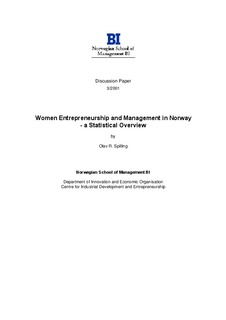| dc.description.abstract | This paper presents a statistical analysis of the current situation for women and men in business. Based on the extraordinary access we have had to important Norwegian databases, the data gives the most comprehensive statistics published on operating businesses in Norway.
In general there seems to be a balance of around 20-80 percent indicating the share between women and men as actors in economic life. On average women account for 21 percent of all start-ups as recorded by the VAT Register, and women account for 18 percent of all managers as recorded by the National Firm Register. Among all firms organised as sole proprietorships women hold a 21 percent share, and also among owner-managed firms, women have a similar share.
When economic factors are considered, it is revealed that the economic importance of a business started or managed by women is less than those organised by men. Although the vast majority of all firms are small, businesses operated by women tend to be distributed even more towards the lower end of the scale than those of men. Thus, in the larger companies a very small minority of CEO positions are held by women. Among joint stock companies the percentage is just 2,2.
This tendency may also be supported by the fact that among all board chairmen, women account for no more than ten percent. When we look at Norwegian employment figures in total, it turns out that women’s firms account for only 6.4 percent of all employment. On the whole, the imbalance between men and women in economic life is severe. There is a long way to go before an acceptable balance between men and women is found in Norwegian economic life.
The role of women as starters and managers of businesses are to a great extent reflected by their traditional roles in the labour market. Thus, the most important sectors for women to start and organise business are mostly in ‘soft sectors’ like personal services and retail. But there are also important groups of women in consultancy services and in agriculture.
Findings regarding the performance of women’s firms may be in contrast to traditional perceptions of female owned businesses. First, our data indicate that the survival rate of firms started by women is slightly lower than for men. Although the differences are not very significant and the data reliability may be questioned, the difference may be explained by the propensity of women to start businesses that are more marginal than those started by men.
Second, the performance of women’s firms as assessed by credit rating scores, do not confirm that women’s firms are more healthy or viable in economic terms than men’s firms. Although the picture is complicated, there is a tendency that economic performance of women’s firms by and large is slightly more toward the low performance end of the scale. | en |
